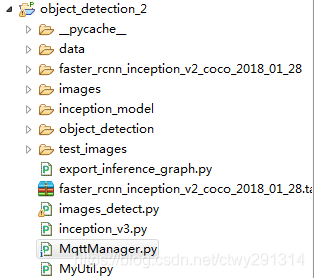基于谷歌开源的TensorFlow Object Detection API视频物体识别系统搭建自己的应用(四)
本章主要内容是利用mqtt、多线程、队列实现模型一次加载,批量图片识别分类功能
目录结构如下:

mqtt连接及多线程队列管理
# -*- coding:utf8 -*-
import paho.mqtt.client as mqtt
from multiprocessing import Process, Queue
import images_detect
MQTTHOST = "192.168.3.202"
MQTTPORT = 1883
mqttClient = mqtt.Client()
q = Queue()
# 连接MQTT服务器
def on_mqtt_connect():
mqttClient.connect(MQTTHOST, MQTTPORT, 60)
mqttClient.loop_start()
# 消息处理函数
def on_message_come(mqttClient, userdata, msg):
q.put(msg.payload.decode("utf-8")) # 放入队列
print("产生消息", msg.payload.decode("utf-8"))
def consumer(q, pid):
print("开启消费序列进程", pid)
# 多进程中发布消息需要重新初始化mqttClient
ImagesDetect = images_detect.ImagesDetect()
ImagesDetect.detect(q)
# subscribe 消息订阅
def on_subscribe():
mqttClient.subscribe("test", 1) # 主题为"test"
mqttClient.on_message = on_message_come # 消息到来处理函数
# publish 消息发布
def on_publish(topic, msg, qos):
mqttClient.publish(topic, msg, qos);
def main():
on_mqtt_connect()
on_subscribe()
for i in range(1, 3):
c1 = Process(target=consumer, args=(q, i))
c1.start()
while True:
pass
if __name__ == '__main__':
main()
图片识别
images_detect.py
# coding: utf-8
import numpy as np
import os
import sys
import tarfile
import tensorflow as tf
from object_detection.utils import label_map_util
from object_detection.utils import visualization_utils as vis_util
import cv2
import decimal
import MyUtil
context = decimal.getcontext()
context.rounding = decimal.ROUND_05UP
class ImagesDetect():
def __init__(self):
sys.path.append("..")
MODEL_NAME = 'faster_rcnn_inception_v2_coco_2018_01_28'
MODEL_FILE = MODEL_NAME + '.tar.gz'
# Path to frozen detection graph. This is the actual model that is used for the object detection.
PATH_TO_CKPT = MODEL_NAME + '/frozen_inference_graph.pb'
# List of the strings that is used to add correct label for each box.
PATH_TO_LABELS = os.path.join('data', 'mscoco_label_map.pbtxt')
NUM_CLASSES = 90
tar_file = tarfile.open(MODEL_FILE)
for file in tar_file.getmembers():
file_name = os.path.basename(file.name)
if 'frozen_inference_graph.pb' in file_name:
tar_file.extract(file, os.getcwd())
# ## Load a (frozen) Tensorflow model into memory.
self.detection_graph = tf.Graph()
with self.detection_graph.as_default():
od_graph_def = tf.GraphDef()
with tf.gfile.GFile(PATH_TO_CKPT, 'rb') as fid:
serialized_graph = fid.read()
od_graph_def.ParseFromString(serialized_graph)
tf.import_graph_def(od_graph_def, name='')
# ## Loading label map
# Label maps map indices to category names, so that when our convolution network predicts `5`, we know that this corresponds to `airplane`. Here we use internal utility functions, but anything that returns a dictionary mapping integers to appropriate string labels would be fine
label_map = label_map_util.load_labelmap(PATH_TO_LABELS)
categories = label_map_util.convert_label_map_to_categories(label_map, max_num_classes=NUM_CLASSES, use_display_name=True)
self.category_index = label_map_util.create_category_index(categories)
self.image_tensor = self.detection_graph.get_tensor_by_name('image_tensor:0')
# 每个框代表一个物体被侦测到
self.boxes = self.detection_graph.get_tensor_by_name('detection_boxes:0')
# 每个分值代表侦测到物体的可信度.
self.scores = self.detection_graph.get_tensor_by_name('detection_scores:0')
self.classes = self.detection_graph.get_tensor_by_name('detection_classes:0')
self.num_detections = self.detection_graph.get_tensor_by_name('num_detections:0')
def detect(self, q):
with self.detection_graph.as_default():
config = tf.ConfigProto()
# config.gpu_options.allow_growth = True
config.gpu_options.per_process_gpu_memory_fraction = 0.2
with tf.Session(graph=self.detection_graph, config=config) as sess:
while True:
img_src = q.get()
print('------------start------------' + MyUtil.get_time_stamp())
image_np = cv2.imread(img_src)
# 扩展维度,应为模型期待: [1, None, None, 3]
image_np_expanded = np.expand_dims(image_np, axis=0)
# 执行侦测任务.
(boxes, scores, classes, num_detections) = sess.run(
[self.boxes, self.scores, self.classes, self.num_detections],
feed_dict={self.image_tensor: image_np_expanded})
# 检测结果的可视化
vis_util.visualize_boxes_and_labels_on_image_array(
image_np,
np.squeeze(boxes),
np.squeeze(classes).astype(np.int32),
np.squeeze(scores),
self.category_index,
use_normalized_coordinates=True,
line_thickness=8)
print('------------end------------' + MyUtil.get_time_stamp())
# cv2.imshow('object detection', cv2.resize(image_np, (800, 600)))
if cv2.waitKey(25) & 0xFF == ord('q'):
cv2.destroyAllWindows()
break
import time
def get_time_stamp():
ct = time.time()
local_time = time.localtime(ct)
data_head = time.strftime("%Y-%m-%d %H:%M:%S", local_time)
data_secs = (ct - int(ct)) * 1000
time_stamp = "%s.%03d" % (data_head, data_secs)
return time_stamp
效果:

基于谷歌开源的TensorFlow Object Detection API视频物体识别系统搭建自己的应用(四)的更多相关文章
- 对于谷歌开源的TensorFlow Object Detection API视频物体识别系统实现教程
本教程针对Windows10实现谷歌近期公布的TensorFlow Object Detection API视频物体识别系统,其他平台也可借鉴. 本教程将网络上相关资料筛选整合(文末附上参考资料链接) ...
- 谷歌开源的TensorFlow Object Detection API视频物体识别系统实现教程
视频中的物体识别 摘要 物体识别(Object Recognition)在计算机视觉领域里指的是在一张图像或一组视频序列中找到给定的物体.本文主要是利用谷歌开源TensorFlow Object De ...
- 谷歌开源的TensorFlow Object Detection API视频物体识别系统实现(二)[超详细教程] ubuntu16.04版本
本节对应谷歌开源Tensorflow Object Detection API物体识别系统 Quick Start步骤(一): Quick Start: Jupyter notebook for of ...
- 谷歌开源的TensorFlow Object Detection API视频物体识别系统实现(一)[超详细教程] ubuntu16.04版本
谷歌宣布开源其内部使用的 TensorFlow Object Detection API 物体识别系统.本教程针对ubuntu16.04系统,快速搭建环境以及实现视频物体识别系统功能. 本节首先介绍安 ...
- 安装运行谷歌开源的TensorFlow Object Detection API视频物体识别系统
Linux安装 参照官方文档:https://github.com/tensorflow/models/blob/master/research/object_detection/g3doc/inst ...
- 使用Tensorflow object detection API——训练模型(Window10系统)
[数据标注处理] 1.先将下载好的图片训练数据放在models-master/research/images文件夹下,并分别为训练数据和测试数据创建train.test两个文件夹.文件夹目录如下 2. ...
- 基于TensorFlow Object Detection API进行迁移学习训练自己的人脸检测模型(二)
前言 已完成数据预处理工作,具体参照: 基于TensorFlow Object Detection API进行迁移学习训练自己的人脸检测模型(一) 设置配置文件 新建目录face_faster_rcn ...
- 基于TensorFlow Object Detection API进行相关开发的步骤
*以下二/三.四步骤确保你当前的文件目录是以research文件夹为相对目录. 一/安装或升级protoc 查看protoc版本命令: protoc --version 如果发现版本低于2.6.0或运 ...
- 使用TensorFlow Object Detection API+Google ML Engine训练自己的手掌识别器
上次使用Google ML Engine跑了一下TensorFlow Object Detection API中的Quick Start(http://www.cnblogs.com/take-fet ...
随机推荐
- HTML中表格table标签的实例
一.表格有边框,第一行居中对齐 二.表格没有边框 三.表格有水平标题 四.表格有垂直标题 五.合并行单元格 colspan合并单元格 六.表格有单元格边距(内边距) 七.表格没有单元格间距 八.表格有 ...
- luogu 2219[HAOI2007]修筑绿化带 单调队列
Code: #include<bits/stdc++.h> using namespace std; #define setIO(s) freopen(s".in",& ...
- (容量超大)or(容量及价值)超大背包问题 ( 折半枚举 || 改变 dp 意义 )
题意 : 以下两个问题的物品都只能取有且只有一次 ① 给你 N 个物品,所有物品的价值总和不会超过 5000, 单个物品的价格就可达 10^10 ,背包容量为 B ② 给你 N (N ≤ 40 ) 个 ...
- 【bzoj3195】【 [Jxoi2012]奇怪的道路】另类压缩的状压dp好题
(上不了p站我要死了) 啊啊,其实想清楚了还是挺简单的. Description 小宇从历史书上了解到一个古老的文明.这个文明在各个方面高度发达,交通方面也不例外.考古学家已经知道,这个文明在全盛时期 ...
- luogu P1147 连续自然数和 x
P1147 连续自然数和 题目描述 对一个给定的自然数M,求出所有的连续的自然数段,这些连续的自然数段中的全部数之和为M. 例子:1998+1999+2000+2001+2002 = 10000,所以 ...
- C# 字符串的长度问题
string str = "aa奥奥"; 如果直接取 str.length,取的就是字符的长度,一个汉字也是一个字符,长度就是4. 一个汉字是两个字节,如果需要统计字节数,可以用下 ...
- nginx 入门 安装
.yum解决编译nginx所需的依赖包,之后你的nginx就不会报错了 yum install gcc patch libffi-devel python-devel zlib-devel bzip2 ...
- Glide 图片框架
学习参考:https://blog.csdn.net/guolin_blog/article/details/53759439 一 基础使用 Picasso比Glide更加简洁和轻量,Glide比Pi ...
- original和source的区别
最近跟网页翻译怼上了,在给翻译前的页面起名是纠结于使用original page还是source page,就查了一下original和source的区别. original: n. 原件:原作:原物 ...
- curl发json
linux 模拟post请求 curl -X POST \ -H "Content-Type: application/json" \ -H "token:GXJP1cl ...
